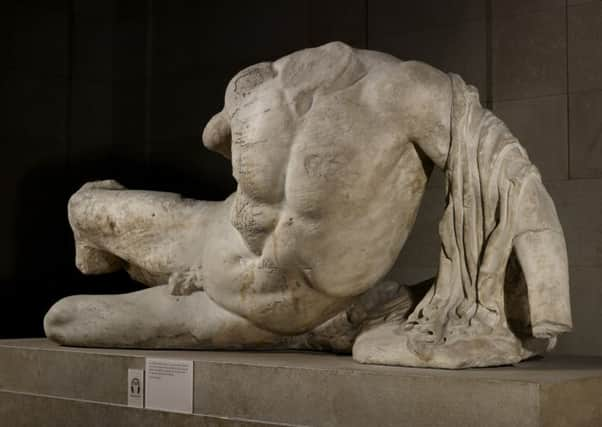Comment: Elgin marbles are not political pawns


It’s not often news about old marble hits the headlines, but these 2,500-year-old sculptures, taken by the Scot, Thomas Bruce, seventh Earl of Elgin and 11th Earl of Kincardine, are exceptional – the greatest works of art in human history.
Neil MacGregor, director of the British Museum, has just sent one of the sculptures to Russia, on a temporary basis, following a request from the Hermitage to mark the 250th anniversary of its foundation. In so doing, he has dramatically changed the terms of the dispute. But not, I suspect, for the better.
Advertisement
Hide AdAdvertisement
Hide AdThe sculpture, unveiled today in St Petersburg after being transported from London in total secrecy, is of Ilissos, a Greek river god; a marble figure of an athletic young man, just over life-sized, drawing himself up on to a bank, from the west pediment of the Parthenon. He is unclothed, except for a piece of drapery falling over his left side, so artfully carved that the cloth appears to turn into water running across his arm.
He has been sent in the services of soft power. Neil MacGregor said: “The politics of both museums have been that the more chilly the politics between governments, the more important the relationship between museums.”
Like the pandas in Edinburgh Zoo, it is thought this marble, naked, male torso will work wonders for world peace, that it will warm what could be a new Cold War between Russia and the West. It is a daring move. None of the Elgin Marbles have left Britain since they arrived on its shores some 200 years ago. Many, of course, think that if they were to go anywhere, it should be Greece.
I am firmly in the “they should stay” camp. The present situation – where half the remaining sculptures are in Athens, and the rest are in London – means the Marbles can be seen and understood in both Athens, in the Acropolis Museum, close to where they were created, as well as in London, where they can be seen in relation to an encyclopaedic collection – beside artefacts from multiple human civilisations – aiding an understanding of the influence that the sculptures and the ideal of ancient Athens have had on many other cultures.
But this act of cultural diplomacy has made me wonder about the thinking today behind the purpose of the British Museum and other museums like it.
The loan of this sculpture is a political move. It does not benefit knowledge. The Hermitage is a towering museum, but the sculpture has not been sent – at some risk – some 1,300 miles because it will be situated in any particular, meaningful way. I have no doubt it will impress, and that it will look dramatically different against the largely Roman sculptures in St Petersburg, but it seems to be primarily about the gesture of the act and is therefore unlikely to shed further light on the Parthenon or on ancient Athens. Rather, it appears to serve the interests of the British Museum, in the short term, by making it out to be an essential player in international relations.
In the long term, this does not benefit museums. It continues their transformation from being centres of research and enlightenment into political instruments. MacGregor says of the sculpture that it is a “stone ambassador of the Greek golden age and European ideals”. It is hoped that the piece, perhaps somehow representing the birth of democracy, may improve the situation in Russia. But this is a little forced and rather hopeful. It follows on from another loan, in 2011, of the Cyrus Cylinder, to the National Museum of Iran, similarly justified with the aim of creating tolerance and improving relations. An overall strategy which imposes a particular meaning and purpose on precious artefacts, one that burdens them with a responsibility to facilitate harmony.
The loan of Ilissos will in no way improve the relationship between the Russia and the West. Objects, however remarkable, cannot achieve such things. Soft power can soften difficult relations, but only when done quietly and in conjunction with other measures. This is no such case: it is all far too explicit. And these overstated arguments for what museums and their artefacts can do endorses a simplified approach to international relations. Conflicts of national interest and historical troubles are reduced to acts of misunderstanding that museums can demystify and help resolve. It could backfire in the long run, as too much will be expected of museums and their treasures, whilst at the same time the core role they should perform – research and dissemination – is undervalued.
Advertisement
Hide AdAdvertisement
Hide AdBesides, loans put these great and unique works at risk. The British Museum is acclaimed as the most generous lending collection in the world. More than 5,000 objects travelled to 335 venues in the UK and internationally in 2013-14. I doubt that sending works of art all over the world, in this frenetic, legitimacy-seeking fashion, is wise.
The problem is that all sides in this battle increasingly advance an instrumental role for museums and artefacts. Those arguing the Elgin Marbles should be returned to Greece suggest doing so would aid tourism and affirm the identity of the Greek people. Those arguing that the Marbles should stay in London now argue they can melt frosty relations between nations. We hear less and less about the sculptures at the heart of the dispute and the people that created them.
Despite all the fuss about the Marbles, we are forgetting to think about them for what they are: antiquity. They have become the pawns of wider social, cultural and political tussles amidst which their significance is lost.
The debate over museums and their artefacts is too much about us; what culture can do for us today. It is not enough about the object or its past.